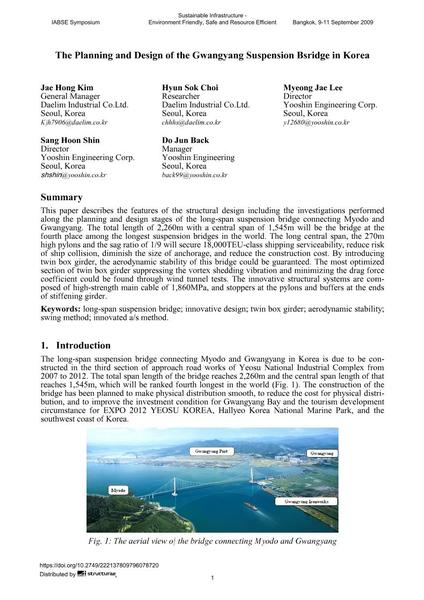The Planning and Design of the Gwangyang Suspension Bridge in Korea

|
|
|||||||||||
Bibliographic Details
| Author(s): |
Jae Hong Kim
Hyun Sok Choi Myeong Jae Lee Sang Hoon Shin Do Jun Back |
||||
|---|---|---|---|---|---|
| Medium: | conference paper | ||||
| Language(s): | English | ||||
| Conference: | IABSE Symposium: Sustainable Infrastructure - Environment Friendly, Safe and Resource Efficient, Bangkok, Thailand, 9-11 September 2009 | ||||
| Published in: | IABSE Symposium Bangkok 2009 | ||||
|
|||||
| Page(s): | 138-147 | ||||
| Total no. of pages: | 8 | ||||
| Year: | 2009 | ||||
| DOI: | 10.2749/222137809796078720 | ||||
| Abstract: |
This paper describes the features of the structural design including the investigations performed along the planning and design stages of the long-span suspension bridge connecting Myodo and Gwangyang. The total length of 2,260m with a central span of 1,545m will be the bridge at the fourth place among the longest suspension bridges in the world. The long central span, the 270m high pylons and the sag ratio of 1/9 will secure 18,000TEU-class shipping serviceability, reduce risk of ship collision, diminish the size of anchorage, and reduce the construction cost. By introducing twin box girder, the aerodynamic stability of this bridge could be guaranteed. The most optimized section of twin box girder suppressing the vortex shedding vibration and minimizing the drag force coefficient could be found through wind tunnel tests. The innovative structural systems are com- posed of high-strength main cable of 1,860MPa, and stoppers at the pylons and buffers at the ends of stiffening girder. |
||||
| Keywords: |
Innovative Design aerodynamic stability long-span suspension bridge twin box girder swing method innovated a/s method
|
||||
